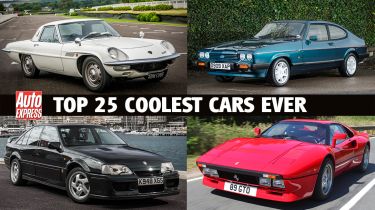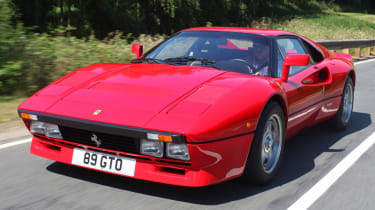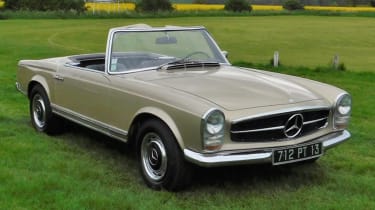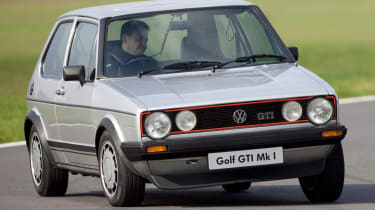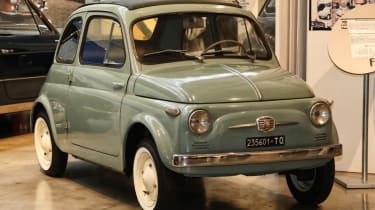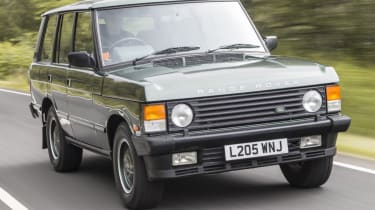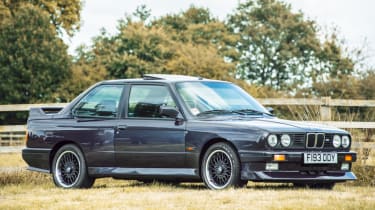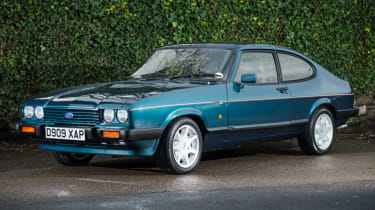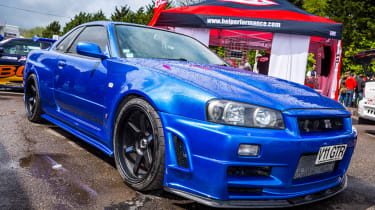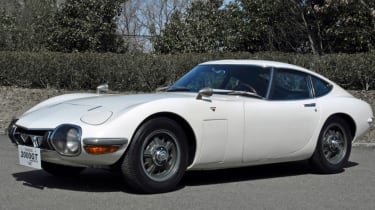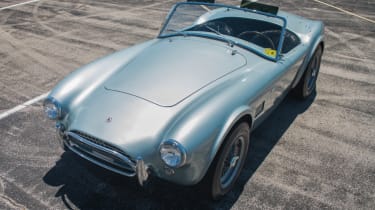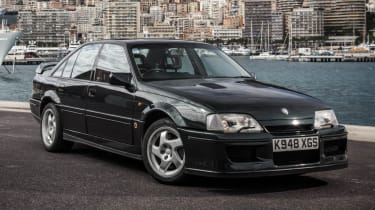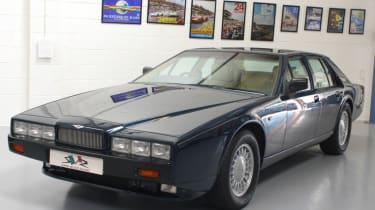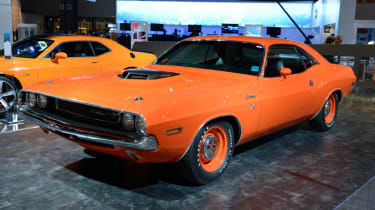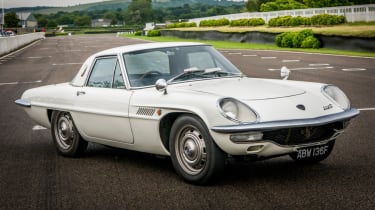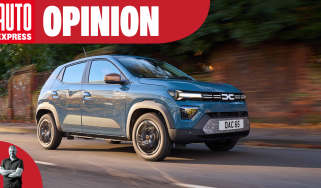Cool cars: the top 25 coolest cars in the world
Our cool cars poll revealed the top 25 coolest cars in the world according to you. And here they are…
What makes a cool car? Well it's not an exact science, as you might imagine, and everybody has a different opinion. That's why we asked some of the best informed people around - the readers of AutoExpress, no less. Here are the results: it's the 25 coolest cars ever built.
The cool cars here are the ones that took pride of place as posters on bedroom walls, or these days can be found gracing the backgrounds or wallpapers on computer or smartphone screens. They have an ageless quality that puts them down as instant classics, but there's something more to them that helps their cool cause. It can be down to looks, achievements, the technology on board, or even the performance, there's no fixed definition of what makes a car cool but when you see a cool car you know it.
A motorsport connection is a sure-fire good way of earning cool status. While plenty of cars get a sporty makeover in the quest for sales, the cool cars are the ones that have the racing or rallying pedigree that justify their existence. A limited production run that's designed to meet a homologation requirement - like the uber-rare Lancia Stratos, only ramps up the cool factor further, while cars that are little more than thinly disguised racing cars with number plates also deliver a cool factor that few others can match. The inherent risk of danger that is associated with motorsport also promotes the image of cool surround cars bred for speed.
The car's model name can also be crucial to its image. Something like a Shelby Cobra conjures up connotations of a deadly animal, although the exception to this would be Ferrari - who seem to get by just fine with mere numbers.
There could even be a celebrity connection - the cool factor of somebody famous is likely to rub off on whatever they drive, just look at film star Steve McQueen. If it wasn't for the car chase in the movie Bullitt, would the Ford Mustang be as revered as it is?
Understatement can also give a car the cool factor. While other cars look big and brash with a real 'look at me' attitude, some cool cars are more reserved, and don’t need to shout about their presence. Whether it's classically elegant lines or simply a look that doesn't make a song and dance about a car's potential performance, subtlety is another way to collect cool points. The sheer price tag can be enough to convince some of a car's coolness, but the one thing we know for sure is that ‘cool’ is highly subjective and defining it can be very tricky.
So, without further ado, here are the cars that made our top 10, as voted for by users of autoexpress.co.uk. We've also listed the models that came in places 11 to 25 below. Click the links to find out more about the world’s coolest cars.
Top 10 coolest cars in the world
- Citroen DS
- Jaguar E-Type
- Lancia Stratos
- Land Rover Defender
- Lamborghini Miura
- Mini
- Lotus Esprit
- Porsche 911
- Audi Quattro
- McLaren F1
Coolest cars 11-25
Our poll of over 6,000 Auto Express readers revealed the top 10 coolest cars in the world but many super-cool vehicles missed the cut. Below are the models that placed 11th to 25th in the poll.
11. Ferrari 288 GTO
- Years: 1984-1987
- Number built: 272
Fun fact: ‘GTO’ stands for Gran Turismo Omologato – the latter translating from Italian to mean homologated. This is a clue to how the 288 GTO came into existence, it was created to allow Ferrari to compete in Group B races. Not alongside Group B rally icons such as the Audi Quattro, though; it was to lock horns with the likes of Porsche’s 959 on good old-fashioned race tracks.
From the outside, Ferrari’s 288 GTO looks similar to the more run-of-the-mill (for a Ferrari, at least) 308 GTB. Despite both featuring a sleek low-slung body the two are in fact quite different. As an example, the 288 GTO had a longer wheelbase, flared wheel arches (to house bigger wheels) and a front spoiler. Perhaps the most important difference is that the 288 GTO used a tubular chassis rather than a semi-monocoque, as in the 308 GTB.
Furthermore, Ferrari blessed its 288 GTO with a cracking 2.8-litre V8 twin-turbo engine that was mounted behind the driver. The V8 was claimed to produce 400bhp and was capable of reaching 60mph from a standstill in a mere 4.9 seconds. Keep the throttle pinned and work up through the five-speed gearbox, and a 288 GTO will hit 189mph flat out. All models are believed to come with a limited-slip differential, too.
While the 288 GTO is undeniably fast, Ferrari also made ‘Evoluzione’ race-spec models, which are claimed to produce 650bhp and have a top speed of 225mph (depending on gearing). Irrespective of version, all 288 GTO models are eye-wateringly expensive with prices often surpassing two million pounds.
12. Mercedes-Benz 280 SL Pagoda
- Years: 1967-1971
- Number built: 23,885
When Mercedes launched its 280 SL back in the late 1960s (replacing the 250 SL) it was in an era where the most desirable cars came with ample grace and pace. Which is a lot more than can be said for some high-end cars these days.
Regardless, more than 50 years on Mercedes’ design still looks stunning despite the relatively simple (by modern standards) body shape. The geometry of the SL’s removable coupe top reminded people of East Asian temple roofs and it soon became known as the Pagoda.
Inside, it’s much the same desirable yet classy affair as the outside. The large, thin steering wheel, big round dials and subtle touches of chrome all work together to ooze sophistication. Countless famous faces have owned 280SLs, including the likes of John Lennon and Kate Moss.
All models use a six-cylinder petrol engine that sends power to the rear wheels, and while performance isn’t excessive (roughly 180bhp is on offer) it was more than enough to be one of the fastest cars on the road when launched. Speed is only half the story, though. The 280 SL was also comfortable, and thanks to some good old fashioned German engineering it could go on being comfy mile after mile without breaking down.
For the ultimate comfy sports cruiser, the rare five-speed automatics take the biscuit – although the much more common four-speed automatic still works well. Mercedes also offered a four-speed manual, which, although less popular when new than automatic transmissions, it is a peach to use.
Today the 280SL Pagoda continues to be an icon – it is basically Germany’s take on the Jaguar E-Type. Prices vary greatly depending on condition but don’t expect much change from £100,000 for your average model, while you’ll need nearer £200,000 for low-mileage top-end versions. Those hoping that the 280’s predecessors – the 250 and 230 – are significantly cheaper will be disappointed because the prices can be remarkably similar.
13. Volkswagen Golf GTI
- Years: 1979-1984 (RHD)
- Number built: 462,000
Although not the very first hot hatch to have ever been made, Volkswagen’s Golf GTI didn’t half make a success of it. As the story goes, VW engineers decided that while the standard Golf was a good car, it really needed a little more fire in its belly. So, in their spare time (between designing normal car parts and eating bratwurst) they tweaked the styling, played with the engine and created an icon.
As many will know, the hot hatchback formula is something of a have-your-cake-and-eat-it scenario. On the one hand, the Mk1 Golf is practical (there are front and rear seats, visibility is great and there is also a relatively large boot) and affordable to run, while the performance and handling are more than enough to put a smile on many a driver’s face.
Powering the original Golf GTI is a 1.6-litre petrol engine that pumps out around 108bhp and 140Nm of torque. These numbers might seem small for a performance car, but the Mk1 GTI weighed in at only 810kg. So it would go from 0-60mph in nine seconds and hit 110mph flat out. A larger 1.8-litre engine arrived later in the Mk1’s life.
Handling is a strong point of the original Golf GTI. It was created in a time before electronic assistance/interference and super-stiff suspension became the norm for sporty hatchbacks. What’s more, the Golf GTI remains somewhat affordable (unlike some of its modern equivalents). The more expensive models cost no more than a nearly new Ford Fiesta ST (around £16,000-£17,000) but there are much more affordable versions that can be scooped up for around half of that.
Check out our test of the classic Volkswagen Golf GTI Mk1 here...
14. Fiat 500
- Years: 1957-1975
- Number built: 3,893,294
Fiat’s 500 was Italy’s answer to those looking for a small, affordable and frugal car – in many ways it’s like a classic Mini. In fact, Fiat tried to get its little car into the original Italian Job film by offering as many as the producers could write off, but the powers that be wanted a British model to take centre stage – despite BMC (British Motor Corporation) being much less open to supplying free or even discounted cars for the film.
Irrespective of missing out on Hollywood fame, the 500 is still loved the world over, with Fiat’s newer versions continuing to sell well. Part of the original’s charm was down to its stylish exterior, dinky proportions and incredibly simple interior. Not all models were born equal, though, because the 500 L (or Lusso – meaning luxury) had a more plush cabin including a different instrument panel and seats.
The driving experience will thaw even the coldest of hearts, despite offering similar speed to a glacier. Floor the throttle and it will take over 30 seconds to get from 0 to 50mph, but then again, the 500’s two-cylinder engine that produced roughly 13bhp was never designed to set land speed records. The lack of power was a deal breaker for some, so it wasn’t long before Fiat launched a Sport model, with around 20bhp.
Prices vary wildly for a 500 today – a large part of this is the difference between those that need a complete restoration and rarer models (such as open-top ‘Jolly’ versions which are ideal for nipping to the beach) that have been completely restored. Still, a budget of £10,000 will get a decent one.
15. Range Rover Classic
- Years: 1970-1996
- Number built: 317,615
Few could have predicted the heights the Range Rover would reach – not least in terms of luxury and off-road prowess but also as the transport of choice for the uber-wealthy and super famous. Yet, nearly 50 years on from its launch the opulent 4x4 is still up there with the best in class.
Part of this success has been Land Rover’s drive for innovation, in fact, the original Range Rover was so innovative it created its own market segment back in the day. The very first model revealed to the world came with three doors and an interior that looked as if it could be cleaned with a hosepipe and a broom. Quite the contrast to the sleek, leather-clad versions that roll off the production line today.
Importantly, though, the Range Rover Classic was (and still is) massively comfortable and hugely capable when the going gets muddy. Such features proved all too alluring for the elite of the day and as a result it wasn’t long before the Range Rover had morphed into a luxurious five-door off-roader.
Early Range Rovers came with coil-spring suspension which blew leaf-sprung alternatives out of the water. Matching this set-up nicely were powerful V8 petrol engines and automatic gearboxes, but there were also diesel engines and manual transmissions. For many, the diesel was the one to have thanks to its ample torque for towing or climbing hillsides but also acceptable fuel economy.
Original Range Rovers continue to be popular and prices for fully restored versions (possibly modified to use a more modern engine) can exceed that of a new model. The entry point to Range Rover Classic ownership are the diesel models, with higher-mileage examples often priced below five figures.
For our review of the classic Range Rover click here...
16. Alfa Romeo Spider
- Years: 1966-1994
- Number built: 110,128
Alfa Romeo is a car manufacturer of two halves – on the one side it has been known to make some of the most beautiful cars and engines in history but on the other it has made some incredibly unreliable cars which rust quicker than you can say ‘get the dustpan and brush’.
Fortunately, the Spider is one of the Italian brand’s better efforts, although it is still wise to check for rust. Back in 1966, Alfa launched its Spider with a 1.6-litre aluminium engine that featured double overhead camshafts, a five-speed manual gearbox and disc brakes all round. While power was rated at a modest 109-ish bhp, the lightweight body and direct steering made for an enjoyable driving experience.
Even so, it wasn’t long before Alfa introduced a more powerful version – called the Spider Veloce – with a 1.8-litre engine and close to 120bhp. To help make the Spider more accessible to some, a Junior model was eventually offered with a 1.3-litre engine that produced just under 90bhp.
Although in the UK Alfa’s little roadster never reached the same sales success of the MGB, it was very popular in other countries. Its status as an Italian icon was partly helped by featuring in that classic Hollywood film, The Graduate. The Spider proved so popular, in fact, that it remained on sale for nearly 30 years, although there were four separate versions of the Italian two-seater sports car during this time.
As for prices, well, those in need of restoration start around the £10,000 to £15,000 mark and pristine models are available for north of £30,000.
17. BMW E30 M3
- Years: 1986-1991
- Number built: 17,970
Let’s not beat around the bush, BMW’s E30 M3 is a legend. It was launched as a race car for the road, but it wasn’t a nightmare to live with because it was still a relatively practical coupe – albeit faster than most other cars on the road.
Even the regular E30 M3 looked the part but Evolution and Sport Evolutions are better still thanks to aggressive angular wheel arches. On top of the standard 3 Series, all M3s came with sporty alloy wheels, twin exhausts and a smattering of M3 badges.
It was under the body, though, that the real magic happened. At the centre of things is a 2.3-litre petrol engine that, once in the upper echelons of its rev range (5,000 to 7,000rpm), comes alive like few others. Power output is claimed to be around 200bhp but Evolution models came with an additional 15bhp. Thanks to a relatively low kerb weight of around 1,200kg an E30 M3 will go from 0-62mph in 6.7 seconds.
The handling is just as special as the engine, with corners offering drivers the chance to revel in the chassis’ balance and directness of the steering. Compared to the entertaining drive, the E30 M3’s interior is a touch boring. It is largely taken wholesale from the standard E30 3 Series, although there are some subtle touches which will make drivers feel special – such as a suede-wrapped gear lever.
Unfortunately for mere mortals, BMW’s sports coupe is so well regarded that prices are sky-high. £70,000 will just about get you a ticket to the show but the more desirable Evolution and Sport Evolution models are regularly priced well into six-figures.
Check out more on the BMW E30 M3 here...
18. Ford Capri
- Years: 1969-1986
- Number built: 1,900,000
While America may have had the original Mustang the UK and Europe had the Capri. In fact, the links between the two were supposed to be more obvious as Ford wanted to call its smaller sports coupe the Colt, but Mitsubishi put an end to that as they already had a model using that name.
First shown to the public in 1969, the Capri was pitched as the affordable fun coupe that could just about squeeze four people into its cabin but deliver heaps of driving fun. This formula proved so popular that almost two million models were sold during a 17-year production run.
To help keep manufacturing costs down Ford used its Cortina’s platform as a base for designing the Capri. When the finished product arrived, it came with leaf springs and drum brakes at the rear and disc brakes mounted to MacPherson struts upfront. Importantly for many drivers, a four-speed manual gearbox was also on hand.
As for engines, there were a fair few but it was (and still is) the 3.0-litre Essex V6 that stole the headlines. It produced 138bhp, which was enough for a top speed north of 100mph and while this may seem unimpressive by today's standards, lest not forget the aforementioned drum brakes and leaf spring suspension.
Back in 1968 £890 was enough to buy a Capri but nowadays you’d struggle to buy one in need of restoration for that. A budget of £5,000 just about gets a running and driving model with one of the less desirable engines (for example, the 1.3-litre petrol) but £10,000 to £15,000 will be enough to get a decent Capri with a more fruity power plant.
For more on the history of the Ford Capri, click here...
19. Nissan Skyline R34
- Years: 1999-2002
- Number built: 11,578
The R34 generation of Nissan’s Skyline GT-R has been immortalised through association with films such as The Fast and the Furious and also their ability to humble much more expensive supercars on the race track. Part of this was thanks to some cutting-edge acronyms the R34 was blessed with, including ATTESA E-TS (which translates to traction control) and Super-HICAS (four-wheel steering).
Nissan’s 2.6-litre and 2.8-litre straight-six twin-turbo engines are something of a legend in car tuning circles thanks to their ability to handle significant power hikes via remaps and/or upgrades to the internals. Curiously, models were stated to come with around 276bhp from the factory but when tested their actual figures were closer to 330bhp. Surprisingly Nissan didn’t get swamped with complaints from owners.
It isn’t just the mechanicals that makes the R34 cool, it looks the part, too. The quad rear lights, spoiler and sporty body kit combine with a two-door coupe body to make one of Japan’s more recognisable cars. All this comes at quite some expense, though, with prices well in excess of £100,000.
Of those that do pop up for sale, many have been modified to some extent so there will likely be competition for any clean original examples. Changes made by owners range from full-blown race car conversions to massive exhaust tips, bigger spoilers and more aggressive styling.
Find out how the R34 stacked up to its R35 predecessor here...
20. Toyota 2000 GT
- Years: 1967-1970
- Number built: 351
Compared to a lot of the cars Japan was producing in the late 1960s Toyota’s 2000 GT is otherworldly. It is an out and out sports car and a rather good one at that. It is quite rare, too, with just 351 believed to have been built during a production run starting in 1967 and ending in 1970.
The 2000 GT is often compared to Jaguar’s E-Type, at least in coupe form, because both models come with swoopy styling and are quite well suited to grand touring. Even so, Toyota didn’t merely copy what the Brits were doing. For example, Toyota used a relatively modest 2.0-litre in-line six-cylinder engine taken from another model in its range: the Crown saloon.
Toyota didn’t design its 2000 GT all by itself, it roped in Yamaha to help spice things up a little. Improvements came in the way of an aluminium cylinder head with twin cams and Mikuni-Solex carburettors – among others. The end product was claimed to produce a modest 176Nm of torque and 148bhp. This was then fed through a five-speed manual gearbox to the rear axle, which came with a limited-slip differential. The end result was a cracking driver's car.
Like many of the coolest cars ever made, Toyota’s 2000 GT has appeared on the big screen, most notably in the 1967 James Bond film You Only Live Twice. What with their desirability you would need to be a movie star to afford a Toyota 2000 GT, although they are so rare sometimes there are none for sale. Those that have been sold in recent years (at auction) have cost between £500,000 and £700,000.
21. AC Cobra
- Years: 1962-1969
- Number built: 998
What do you get when you cross a red-blooded American V8 engine with a ye ole British roadster? The AC Cobra, that's what. To paint the full picture, British manufacturer AC had teamed with icon Carol Shelby to produce a car. AC would manufacture an Ace roadster (minus the engine and gearbox) ship it across the pond where Shelby would shoe-horn a Ford lump under the bonnet.
Chevrolet engines were planned to be used but it was Ford that showed the most enthusiasm. At first, Shelby used Ford’s 7.5-litre V8 but it was the 4.7-litre (or 289 cubic inch) V8 which would become the most famous engine. That said, the 7.0-litre unit later introduced to make the Cobra more competitive on the GT racing scene also grabbed attention – these models also got heavily revised suspension and a modified chassis, too. Some of the 7.0-litre models were built for racing and some for road use – the latter known as ‘427 Cobra S/Cs’ with S/C standing for ‘semi-competition’.
In truth the beautiful roadster body didn’t lend itself to high speeds from an aerodynamics point of view, so six special coupe models were commissioned with bespoke bodywork to make the cars more competitive, especially at the all-important Le Mans. Interestingly, all six still exist, despite the tax man threatening to throw some into the sea.
Shelby’s Cobra lasted until 1967, but the AC’s version (called the AC 289) lived for two years longer. Even then the Cobra wasn’t truly dead and there have been countless kits for people to build their own Cobra (using a donor car) and even pricey recreation models.
22. Vauxhall Lotus Carlton
- Years: 1990-1992
- Number built: 950
Sometimes, out of nowhere, a star is born. This is exactly what happened with the Lotus Carlton. Originally designed as a brand-building exercise between Vauxhall and Lotus, who were both then owned by General Motors, the sports saloon burst onto the scene with an outrageous top speed and acceleration that could worry even the most exotic supercars of the time.
For reference, the Carlton’s rivals from BMW and Mercedes were typically limited to 155mph, while the Vauxhall would plough on all the way to 176mph. This number was heralded as scandalous by some and there were even calls from the ‘popular’ press to restrict the top speed for safety reasons. Although far from brash, the styling was somewhat menacing, what with its flared arches, boot spoiler and dark Imperial Green (which was the only colour available from the factory).
Lotus’s involvement was far from a kiss-me-quick affair. Engineers fettled with the standard model’s 3.0-litre straight-six engine, increasing its capacity to 3.6 litres and adding two turbos – this set-up was claimed to produce 377bhp and 568Nm of torque from the factory. The suspension was also engineered to improve handling, and bigger brakes were on hand to help bring drivers back down to earth after flooring it. Grippier tyres were also used, which no doubt helped the Carlton achieve its official 0 to 60mph time of 5.0 seconds.
Only 950 units made and just 250 were UK-spec and right-hand-drive. As a result, they are a rare sight these days. That said, prices are competitive (if a little erratic) compared to the likes of the E30 M3 – think somewhere between £50,000 to £70,000. Super-low-mileage examples do occasionally pop up for in excess of £100,000, though.
23. Aston Martin Lagonda
- Years: 1976-1990
- Number built: 640
The 1970s Aston Martin Lagonda looks like something out of a science fiction film. It was designed by a man named William Towns and although seeing a Lagonda on the road is a rare sight indeed, the striking wedge-shaped design is instantly recognisable.
It was both massively ahead of its time and very much of its time. Production models first started arriving in 1978 and they were awash with futuristic electronics, such as touch-sensitive buttons on the dashboard. Unfortunately, some of this technology was known to have reliability troubles – which is very much period correct for some British cars.
As the Lagonda was pitched as a luxurious and comfortable saloon, it came with a suitable engine. A 5.3-litre V8 petrol unit was mated to a three-speed automatic gearbox that produced around 280bhp in early models. Series 1 and 2 models used carburettors while Series 3 and 4 versions came with more modern fuel injection. Officially, the Lagonda’s 0-60mph time is 8.8 seconds but then again, it would be terribly uncouth to even attempt as much in such a high-class automobile.
As with many iconic cars of the 20th century, the Lagonda features pop up headlights. It also came with a briefcase, which hints as to the type of affluent clientele Aston was targeting. Even now, buyers will need to be quite wealthy, as prices regularly sit around the six-figure mark.
24. Dodge Challenger
- Years: 1970-1974
- Number built: 165,437
The original 1970s Dodge Challenger has it all (from a muscle car point of view), although thanks to a huge number of engine and trim options some are considerably more desirable than others. Of the eight available V8 engines, it was (and still is) the 7.0-litre Hemi V8 used in R/T models that is the most muscular. It produced more than 400bhp and north of 650Nm so, despite the Challenger’s size, it promises serious performance.
When Dodge first launched the Challenger it was popular for car makers to throw all kinds of optional extras and equipment at their models – such levels of personalisation are fairly common among manufacturers today. As a result, buyers could choose from a shaker hood (which means the air intake protrudes out of the bonnet but is mounted to the engine, so it can be seen shaking when driving) and/or leather seats, vinyl stickers, leather seats, dual exhaust tips and so on.
Much like the Ford Mustang, the Challenger was available as a coupe or a convertible, although the Dodge never really enjoyed the same sales success – partly because it targeted the upper end of the pony car class so was more expensive. It also wasn’t around for that long before the 1973 oil crisis hit, which had a huge (negative) impact on gas-guzzling muscle car sales.
Some features, such as the shaker hood, were only available for select periods during the Challenger’s production run and this rarity makes them more desirable to buyers now. As a result, prices can fluctuate greatly – ranging from £30,000 to £40,000 for less desirable models in need of some TLC all the way up to £1.5 million for rare convertible Hemi R/T versions in great condition.
25. Mazda Cosmo
- Years: 1967-1972
- Numbers built: 1,176
Mazda is one of the few modern-day car manufacturers that really tried using the rotary engine. While the Japanese car maker doesn’t currently have a solely rotary-powered car in its range, it is expected to bring in rotary range-extenders for electric cars at some point.
Such developments are all well and good but they are nothing to do with a small coupe that arrived in the late 1960s. The coupe in question was called the Cosmo Sport (sometimes more simply, the Cosmo) and was Mazda’s first production car to use the Felix Wankel rotary engine. The finished product was very easy on the eye and a delight to drive – the distinctive howl of the oddball engine being a particular highlight.
Being that the rotary engine is both lighter and smaller than a conventional piston engine, it lends itself very well to good weight distribution and a strong bhp per tonne ratio – both of which are important for sports cars.
Despite offering so much less than 1,200 Cosmo Sports were made and of those only a handful found owners outside of Japan. Anyone hoping to buy one now will find it difficult, especially in the UK. That said, at the time of writing two were for sale, one priced at £60,000 and the other price on application, which can often translate to eye-watering figures.
Tell us about any cool cars you think were overlooked in the comments section below…

